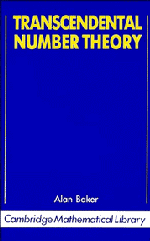Book contents
- Frontmatter
- Contents
- Preface
- 1 The origins
- 2 Linear forms in logarithms
- 3 Lower bounds for linear forms
- 4 Diophantine equations
- 5 Class numbers of imaginary quadratic fields
- 6 Elliptic functions
- 7 Rational approximations to algebraic numbers
- 8 Mahler's classification
- 9 Metrical theory
- 10 The exponential function
- 11 The Siegel–Shidlovsky theorems
- 12 Algebraic independence
- Bibliography
- Original papers
- Further publications
- New developments
- Index
5 - Class numbers of imaginary quadratic fields
Published online by Cambridge University Press: 01 June 2011
- Frontmatter
- Contents
- Preface
- 1 The origins
- 2 Linear forms in logarithms
- 3 Lower bounds for linear forms
- 4 Diophantine equations
- 5 Class numbers of imaginary quadratic fields
- 6 Elliptic functions
- 7 Rational approximations to algebraic numbers
- 8 Mahler's classification
- 9 Metrical theory
- 10 The exponential function
- 11 The Siegel–Shidlovsky theorems
- 12 Algebraic independence
- Bibliography
- Original papers
- Further publications
- New developments
- Index
Summary
Introduction
The foundations of the theory of binary quadratic forms, the fore runner of our modern theory of quadratic fields, were laid by Gauss in his famous Disquisitiones Arithmeticae. Gauss showed, amongst other things, how one could divide the set of all binary quadratic forms into classes such that two forms belong to the same class if and only if there exists an integral unimodular substitution relating them, and he showed also how one could combine the classes into genera so that two forms are in the same genus if and only if they are rationally equivalent. He also raised a number of notorious problems; in particular, in Article 303, he conjectured that there are only finitely many negative discriminants associated with any given class number, and moreover that the tables of discriminants which he had drawn up in the cases of relatively small class numbers were in fact complete. The first part of the conjecture was proved, after earlier work of Hecke, Mordell and Deuring, by Heilbronn in 1934, and the techniques were later much developed by Siegel and Brauer to give a general asymptotic class number formula; but the arguments are non-effective and cannot lead to a verification of the class number tables as sought by Gauss. In 1966, two distinct algorithms were discovered for determining all the imaginary quadratic fields with class number 1, which amounts to a confirmation of the simplest case of the second part of the conjecture.
- Type
- Chapter
- Information
- Transcendental Number Theory , pp. 47 - 54Publisher: Cambridge University PressPrint publication year: 1975



